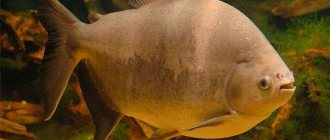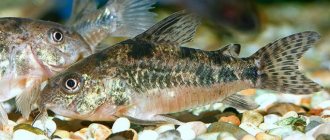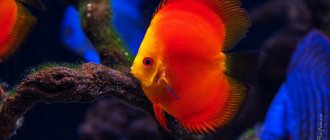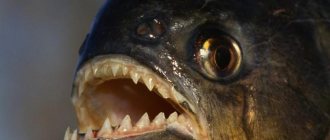The common piranha (lat. Pygocentrus nattereri, or Natterer's piranha) is a species of predatory fish. It belongs to the Serrasalmidae family, and is one of the most famous species of piranha. Thanks to Hollywood films, it is known as a bloodthirsty predator, but are piranhas really that dangerous? Further in the article you will find information about their habitat, how piranhas hunt, how to keep fish in an aquarium, and whether it is possible to keep piranhas together with other inhabitants of the aquarium.
Habitat in nature
The red-bellied piranha was first described in 1858. The Latin name is given in honor of the Austrian naturalist Johann Natterer (1787-1843). There is much debate and disagreement about the taxonomy of the species, so it is possible that the Latin name may change later.
The habitat of the red-bellied piranha is the Amazon River and Amazon rainforest, the coastal basins of the Paraguay-Parana and Northwestern Brazil rivers, as well as the Essequibo River basin. The basins of these rivers are located in Argentina, Bolivia, Brazil, Paraguay, Ecuador, Guyana, Peru and Uruguay.
Lives in rivers, tributaries, small rivulets. Also in large lakes, ponds, flooded forests and plains. The red-bellied piranha is considered the most ferocious of all representatives of this species found in nature. In nature, they live in packs of 20 or more individuals, thus making it easier for them to hunt without becoming victims themselves.
They feed on everything they can eat: fish, snails, plants, invertebrates, amphibians. These fish live in huge schools that spend most of their time searching for prey. The fish is quite voracious. Therefore, it can only live in waters rich in fish. Most often, red-bellied piranhas can be found in shallows, deep and muddy waters.
Are piranhas dangerous? Aggression in nature and aquarium
Based on movies and literature, we know that if we just put our hand in water with piranhas, they will eat it within a minute. Well, maybe it's not so dramatic, but if there is some kind of injury on the hand and blood gets into the water, the piranha can smell it from many kilometers away, and the whole flock will attack the person and leave behind only a skeleton.
Is it really?
First, we must understand whether the piranha is an extremely aggressive creature that attacks anything that moves in the water.
This may sound strange, but piranha is a very cautious fish that poses no threat to humans. There are many known cases where a person swam in water full of piranhas without harming himself.
Jeremy Wade was the one who demonstrated this to the fullest. He put the piranha in a small pool and swam there until several dozen piranhas even approached him. It turns out that piranhas, considered predators hungry for flesh and blood, are actually rather timid fish.
They are known to prefer to live in large schools, so if you see one piranha in the water, there are definitely more of them out there. However, they stay in schools not because in this case it is easier for them to kill a person, but because they themselves are part of the food chain for other larger species of fish. In a pack, the likelihood of being eaten is very low.
Moreover, experiments have shown that when alone, fish do not feel as calm as if they were surrounded by others. However, despite their peaceful attitude towards people, piranhas are real killing machines for other species of fish that are lower in their food chain. Their strong jaws were designed to bite and tear apart, while their hard, muscular bodies are capable of moving and jerking incredibly fast underwater.
The piranha's bite ranges from 67 to 320 newtons, which is quite significant for such a small mouth. This is the strongest bite of any fish (relative to their body size), and is three times stronger than that of alligators of the same size.
However, this does not mean that these fish never bite people or animals that fall into the water. Almost always, this behavior is not due to their aggressiveness, but due to self-defense or abnormal weather conditions. Due to changes in the latter, their behavior changes dramatically from usual.
By abnormal weather conditions we mean the dry season, when rivers become too dry and in holes with water, but cut off from the main flow, many fish are left to starve. These hungry predators gradually begin to devour their own kind and are likely to attack any creature that falls into the water. Sometimes piranhas' tendency towards aggressive behavior is revealed during their spawning season, when they attack people or animals as an act of self-defense. However, such cases are quite rare.
Description
Piranhas grow up to 33 cm in length, but this is in nature, and in an aquarium they are much smaller. The normal life expectancy is about 10 years, but cases have been recorded when they lived more than 20.
The piranha has a powerful, dense, laterally compressed body. They are very easy to identify by their head with a massive lower jaw. Add a powerful tail and a body covered in scales, and you have the perfect portrait of a fast, active killer.
Sexually mature individuals are luxurious in their coloring. Body color can vary, but is generally steel or gray, the sides are silver, and the belly, throat and anal fin are bright red.
Some also have a golden tint on the sides. Juveniles are paler, with a silvery coloration and black spots scattered across their silvery body. Their gill covers, pectoral and anal fins, including the abdomen, are bright red.
The predatory lifestyle affected the size of the eyes and nostrils. Piranhas have a high sense of smell, and they can find their potential prey even in complete darkness among dense vegetation.
Difficulty in content
Due to numerous myths telling about the bloodthirstiness of these fish, piranhas are rarely kept in amateur aquariums, although they also require moderate care. At the same time, the fish is not picky about food; it is quite easy to keep in an aquarium.
However, I cannot recommend this fish to inexperienced aquarists. The fish is large and predatory, even it is better to maintain the aquarium with caution; there have been cases when piranhas injured their owners, for example, during transplantation. This is a truly predatory fish with very sharp teeth.
Most of the bites of aquarists happened due to negligence, but still it is better not to stick your hands into the aquarium again. In addition, it is very demanding on water quality.
Keeping in an aquarium
Despite their reputation as bloodthirsty predators, in captivity red-bellied piranhas are very stressed and very shy. At the slightest sign of danger, the entire flock quickly disappears into the dense vegetation. Young piranhas simply lie on their sides and pretend to be dead.
Piranhas will always stay away from unknown objects in the aquarium. If the fish is not hungry, its first reaction to any object placed in the aquarium will be fear.
However, do not forget that you are dealing with a predator who, when trying to catch you, is quite capable of injuring you. Also, if you don't feed the piranha for a month and by the end of that time they will eat each other, and any object that falls into the tank will provoke them to attack.
Aquarium volume
Piranhas stay in all layers of water. Adult piranhas are quite large; even in an aquarium they grow up to 20 cm. Considering that it is recommended to keep piranhas in schools of 4 individuals or more, the volume for such a school needs 400 liters or more. Please note that as the fish grow, this volume may no longer be sufficient.
Water parameters
The optimal water parameters in the aquarium are the following: T 23-28°C, pH 5.5-7.5, GH 4-15.
Decor in the aquarium
As already mentioned, they are quite shy, and in order for them to feel more comfortable, the aquarium needs places where they can hide. To decorate an aquarium, you can use various elements: stones, driftwood, live and artificial plants.
The main thing is that they do not have sharp edges. When a fish gets scared, it often begins to scurry around the aquarium and can easily get injured.
It is ideal to create an aquarium for piranhas that resembles their natural biotope. This is a densely planted (live planted) aquarium with a few open swimming areas, with dim lighting needed for the plants. Under these conditions, piranhas feel more comfortable, become more active and tend to exhibit their natural behavior.
Filtration
The most important thing in maintenance is always clean water. Check ammonia and nitrate levels weekly using tests, and change the water weekly as well.
It is advisable that the aquarium has a powerful external filter and regular water changes. This is all due to the fact that they actively litter while eating and eat protein foods that quickly rot.
The filter needs to be washed regularly, and this should be done more often than in other aquariums. The best way to understand when the time has come is, again, tests. Don't forget that when washing filter materials, you need to use water from the aquarium!
The way fish feed involves a significant load on the biosystem of the aquarium. That is why powerful filters and weekly water renewal by 25-30% are necessary. Other necessary equipment that you will need is an aerator, a heater, and a lighting system. You can choose the lighting that you like, as piranhas can easily tolerate both dim and bright lighting.
The most important thing in content (and interesting!) is observation. Watch your pets, study, understand, and after a while you will no longer need to be afraid for them. You will see all problems at the inception stage.
Reproduction
It is very difficult to distinguish a female from a male. During spawning, the female's abdomen becomes slightly rounded, and the male becomes a little brighter. Sexual maturity is reached at 2-3 years. As mentioned above, piranhas are very shy fish, so the spawning tank must be placed in a quiet place where no one will disturb the fish. The volume of the spawning tank must be at least 150 liters. water temperature is from 26 to 29 degrees. Water changes should be carried out daily in a volume of 25 to 30% of the total volume of the spawning tank. The bottom must be lined with pebbles. The male builds a nest and jealously guards the clutch. The female is capable of laying up to 1500 eggs. The incubation period lasts from 2 to 14 days. Since piranhas become more aggressive during spawning, very often after spawning it is necessary to remove the female so that the male does not injure her. After the fry appear, the male must also be removed from the spawning area. The fry must be fed 2-3 times a day with cyclops, brine shrimp, and bloodworms. Over time, switching to regular food for Piranhas. Since the fry appear unevenly, it may be necessary to separate older fry from small ones, so the latter can be eaten by older brothers and sisters.
Behavior in the aquarium
In aquariums, piranhas do not attract much attention to themselves. They have neither a bright color (the general body tone of an adult fish is silver with black shades, with a reddish belly and sparkles scattered throughout the body), nor an unusual body shape.
With the exception of their teeth, which are extremely sharp blades, the fish are unlikely to attract the interest of aquarists. In addition, the behavior of piranhas in an aquarium is not something special. Because of this specificity, they are not kept so often in species aquariums, without the company of other fish.
Cannibalism is characteristic of piranhas, like many other fish. Cannibalism is usually caused by an insufficiently large aquarium or lack of food. If there are too many fish in an aquarium, they will inevitably bite each other. In this case, one part of the fish dies, while the other survives due to its high immunity. In addition, their wounds heal quite quickly. After just a few days, the bite is almost invisible.
Aggressive behavior is usually caused by the prey's misbehavior from the point of view of its pack. It may be a sick or injured fish, and it does not matter whether it is a member of their species or another inhabitant of the aquarium.
Preface
Known as a voracious predator, capable of quickly tearing flesh from bone and dangerous to any animal that enters its waters, the Red-bellied Piranha is one of the most famous freshwater fish in the world. As a result, displays of this "bloodthirsty" creature occur in most public aquariums, creepy Hollywood films have been produced and the species has become popular in the aquarium trade.
According to Herbert Axelrod (1976), the myth began when American President Theodore Roosevelt visited the Brazilian Amazon in 1913. He was accompanied by numerous journalists, and the Brazilians staged a series of deceptions, one of which was that the president allegedly “discovered and discovered” a new river, which was then named after him. One of the tributaries of the Aripuanan River was chosen and is still referred to today as the Rio Roosevelt or Rio Teodoro.
When Roosevelt arrived at the river, the Brazilians prepared a surprise - an area of several hundred yards was blocked off, and for several weeks, fishermen released hundreds of adult piranhas there and isolated them there. They informed the President that he and his men should refrain from entering the water, as they would be eaten alive by the terribly vicious fish. Naturally, this news was met with skepticism, and then a cow was driven there. This caused a spectacular, frantic fight for the right to get "their piece" among the trapped, hungry piranhas. After this event, the newspapers were filled with stories about terrible, carnivorous fish, but there was not a single record of the killing of a person by wild piranhas.
According to a number of websites and forums currently devoted to the topic, captive keeping of piranhas and their relatives has undergone a relative boom in recent decades. Many different species are now available, but most wild-caught species are expensive and unaffordable for most hobbyists. Natterer's piranhas, by contrast, are commercially bred, with coin-sized juveniles selling quite cheaply for a fish that requires specialized and ultimately expensive care and maintenance. For enthusiasts this is a great aquarium mate, but serious thought and research is essential before purchasing.
Natterer's piranha has proven difficult to identify for a number of reasons. For example, Pygocentrus piraya and Pygocentrus cariba are endemic to certain river basins (San Francisco in Brazil and Orinoco in Venezuela/Colombia, respectively) and have distinct morphological characters. Pygocentrus nattereri, has an incredibly wide distribution, and color can vary significantly even between individuals of the same population. The color of the fish also varies depending on the type of habitat; fish living in blackwater conditions tend to be darker, with less red-orange color, than those living in clear or white water.
The morphology and structure of adult fish may differ in the head and body shape, the presence or absence of dark spots or a reticulate pattern on the sides and fins.
Piranha (Pygocentrus) - all species have similar conditions of housing, feeding and reproduction.
Feeding
In the wild, piranhas feed primarily on fish; in addition, they attack any mammals when they swim or drink water, as well as birds that fly close to the water. In addition to fish, their diet includes insects, crustaceans, mammals, reptiles and amphibians. Some schools of piranha live under trees at certain times of the year, where the birds build their nests. They patiently wait for the moment when the chick falls out of the nest. But, gathering in flocks of more than a hundred, they can also attack large animals, such as a heron or capybara.
When pursuing its prey, the red-bellied piranha relies on speed and surprise to attack. The entire school attacks and eats the prey, with each fish acting on its own, independently of other members of the school.
In the aquarium, red-bellied piranhas feed on protein foods - fish, fish fillets, frozen shrimp, squid meat, earthworms, and live mice. The daily diet should contain food containing a high amount of protein (fish, shrimp, worms) with some addition of plant components.
But it is not recommended to feed mammals with meat, as it is poorly digested by fish and leads to obesity.
Teenagers should be fed every day, and adults every other day or every day, but in moderation. But to prevent obesity, you should arrange for them one or two fasting days a week.
When feeding on its prey, the piranha cuts through all soft tissue with its razor-sharp teeth and usually leaves the skeleton intact.
They eat quickly and erratically, trying to eat as much as possible for later use. Small pieces of food that fall to the bottom of the aquarium are usually ignored. Thus, it is recommended to give them food in small pieces so that they can swallow it straight away without tearing it. To maintain the red color of fish, their diet must include shrimp or artificial food containing components that enhance the red color.
Nutrition
It is worth feeding once a day. Give enough food so that it is eaten in a few minutes. The food that settles to the bottom will quickly decompose and pollute the water. Piranha will happily eat lean, boneless fish (frozen fish must first be thawed), chopped shrimp, mussels, earthworms, maggots, small fish, beef liver and heart. Occasionally you can feed the Piranha with plant foods (raw potatoes, zucchini, cucumber, lettuce). If, however, the fish has not eaten all the food, then the remains must be removed from the aquarium. Give your pets a fasting day once a week.
Compatibility
The question of whether piranha can live with other species of fish is perhaps the most controversial. Some say that this is impossible, others successfully keep them with very small fish. Most likely, it all depends on many factors: how big the aquarium is, how many plants, water parameters, number of individuals, their nature, how densely they feed, and others.
It is easiest to keep with large species: black pacu, singing catfish, plecostomus, pterygoplichts. The last two get along well with them, as they live in the lower layers and are protected by bone plates.
You can try other fish, but it depends on your luck. Some piranhas do not touch anyone for years, others...
The fish is predatory and certainly not suitable for a role in a community aquarium. They can live alone in an aquarium, but it is better to keep them in a flock.
However, even in a formed group, cases of aggression and cannibalism are not uncommon. As a rule, the largest and most dominant fish leads the school. She takes the best seats and eats first. Any attempts to challenge the current state of affairs end in a fight or even injury to the opponent.
Piranha diseases
Piranhas are hardy fish and get sick very rarely. Diseases are usually caused by inappropriate care. In poor conditions they are susceptible to the following diseases:
- poisoning;
- ichthyophthyriosis;
- tuberculosis;
- oodiniumosis;
- "cotton wool disease"
You should consult a specialist for advice. It is necessary to find out the reasons that caused the disease: determine the level of nitrates in the water, adjust the fish’s diet and regime, and check the water parameters. Medications for these diseases can be purchased at pet stores or veterinary pharmacies. Be sure to read the instructions.











